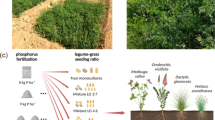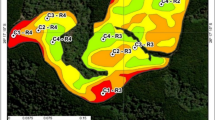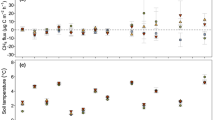Abstract
Through the production of litter, plants with different life history strategies are predicted to both affect and be affected by the properties of soil. Competitive species are expected to increase the fertility of, and have a positive growth feedback with, soil, whereas stress-tolerant species should decrease fertility but show no growth feedback. We maintained monocultures of competitive (Lolium perenne and Agrostis capillaris) and stress-tolerant (Festuca ovina and Nardus stricta) grasses on an unproductive grassland for six years. The Nardus soil developed significantly greater inorganic nitrogen than the Agrostis and Festuca soil, and significantly greater soil moisture content than the Festuca soil. However, there were no differences in organic matter content, phosphate or bulk density between the soil types. In a greenhouse assay, each species was grown in soil cores from the different monocultures as well as natural turf. There were significant differences in growth between plant species and soil types. As expected, L. perenne produced the greatest amount of biomass. However, plants grown on Nardus soil were twice as large and had a 21% lower root allocation than plants grown on any of the other soil types. Lolium perenne, A. capillaris and F. ovina had significant negative growth feedbacks with their own soil (−0.460, −0.821 and −0.792, respectively) and N. stricta had a significant positive feedback (0.560). This study highlights the difficulties of predicting how plant traits will affect soil properties.


Similar content being viewed by others
References
Aerts R, Chapin FS (2000) The mineral nutrition of wild plants revisited: a re-evaluation of processes and patterns. Adv Ecol Res 30:1–67
Atkinson CJ, Farrar JF (1983) Allocation of photosynthetically-fixed carbon in Festuca ovina L. and Nardus stricta L. New Phytol 95:519–531
Berendse F (1998) Effect of dominant plant species on soil during succession in nutrient poor-ecosystems. Biogeochemistry 42:73–88
Binkley D, Giardina C (1998) Why to tree species affect soils? The warp and woof of tree–soil interactions. Biogeochemistry 89:89–106
Chapin FS (1980) The mineral nutrition of wild plants. Annu Rev Ecol Syst 11:233–260
Chapin FS (1991) Integrated responses of plants to stress. Biosciences 41:29–36
Chapin FS, Autumn K, Pugnaire F (1993) Evolution of suites of traits in response to environmental stress. Am Nat 142S:S78–S79
Chapman SK, Langley JA, Hart SC, Koch GW (2006) Plants actively control nitrogen cycling: uncorking the microbial bottleneck. New Phytol 169:27–34
Cole DWJ, Compton H, VM, Homann P (1990) Changes in soil properties and site productivity caused by red alder. Water Air Soil Pollut 54:231–246
Craine JM, Froehle J, Tilman DG, Wedin DA, Chapin FS (2001) The relationships among root and leaf traits of 76 grassland species and relative abundance along fertility and disturbance gradients. Oikos 93:274–285
Crocker RL, Major J (1955) Soil development in relation to vegetation and surface age at Glacier Bay, Alaska. J Ecol 43:427–448
Davidson DA, Bruneau PMC, Grieve IC, Young IM (2002) Impacts of fauna on an upland grassland soil as determined by micromorphological analysis. Appl Soil Ecol 20:133–143
Diaz S, Hodgson JG, Thompson K, Cabido M, Cornelissen JHC, Jalili A, Monsterrat-Marti G, Hamzhehee B, Khoshnevi M, Pérez-Harguindeguy N, Pérez-Rontome MC, Shirvany FA, Vendramini F, Yazdani S, Abbas-Azimi R, Bogaard A, Boustani S, Charles M, Degghan M, de Torres-Espuny L, Falczuk V, Guerrero-Campo V, Hynd A, Jones G, Kowsary E, Kazemi-Saeed F, Maestro-Martínez M, Romo-Díez A, Shaw S, Siavash B, Villar-Salvador P, Zak MR (2004) The plant traits that drive ecosystems: evidence from three continents. J Veg Sci 15:295–304
Ehrenfeld JG, Ravit B, Elgersma K (2005) Feedback in the plant–soil system. Annu Rev Eviron Resour 30:75–115
Eviner VT, Chapin FS (2003) Functional Matrix: A conceptual framework for predicting multiple plant effects on ecosystem processes. Annu Rev Ecol Syst 34:455–485
Flanagan P, Van Cleve K (1983) Nutrient cycling in relation to decomposition and organic matter quality in taiga ecosystems. Can J For Res 13:795–817
Foereid B, Dawson LA, Johnson D, Rangel-Castro JI (2006) Fate of carbon in upland grassland subjected to liming using in situ 13CO2 pulse-labeling. Plant Soil 287:301–311
Gosz JR (1984) Biological factors influencing nutrient supply in forests. In: Bowen GD, Nambiar EKS (eds) Nutrition of plantation forests. Academic, London, pp 119–146
Grime JP (1977) Evidence for the existence of three primary strategies in plants and its relevance to ecological and evolutionary theory. Am Nat 111:1169–1194
Grime JP, Thompson K, Hunt R, Hodgson JG, Cornelissen HC, Rorison IH, Hendry GAF, Ashenden TW, Askew AP, Band SR, Booth RE, Bossard CC, Campbell BD, Cooper JEL, Davison AW, Gupta PL, Hall W, Hand DW, Hannah MA, Hillier SH, Hodkinson DJ, Jalili A, Liu Z, Mackey JML, Matthews N, Mowforth MA, Neal AM, Reader RJ, Reiling K, Ross-Fraser W, Spencer RE, Sutton F, Tasker DE, Thorpe PC, Whitehouse J (1997) Integrated screening validates primary axes of specialization in plants. Oikos 79:259–281
Hector A, Schmid B, Beirerkuhnlein C, Caldeira MC, Diemer M, Dimitrakopulos PG, Finn JA, Freitas H, Giller PS, Good J, Harris R, Högberg P, Huss-Danell K, Joshi J, Jumpponen A, Körner C, Leadley PW, Loreau M, Minns A, Mulder CPH, O’Donovan G, Otway SJ, Pereira JS, Prinz A, Read DJ, Scherer-Lorenzen M, Schulze E-D, Siamantziouras A-SD, Spehn EM, Terry AC, Troumbis AY, Woodward FI, Yachi S, Lawton JH (1999) Plant diversity and productivity in European grasslands. Science 286:1123–1127
Huston MA (1997) Hidden treatments in ecological experiments: re-evaluating the ecosystem function of biodiversity. Oecologia 110:449–460
Jenny H (1980) The soil resource. Springer, New York
Kalra YP, Maynard DG (1991) Methods manual for soil and plant analysis. Forestry Canada, Northwest Region, Northern Forestry Centre, Edmonton, AB
Lipson D, Näsholm T (2001) The unexpected versatility of plants: organic nitrogen use and availability in terrestrial ecosystems. Oecologia 128:305–316
Lovett GM, Weathers KC, Arthur MA, Schultz JC (2004) Nitrogen cycling in a northern hardwood forest: do species matter? Biogeochemistry 67:289–308
Markham JH, Chanway CP (1996) Measuring plant neighbour effects. Funct Ecol 10:548–549
McKane RB, Johnson LC, Shaver GR, Nadelhoffer KJ, Rastetter EB, Fry B, Giblin AE, Kielland K, Kwiatkowski EB, Laundre JA, Murray G (2002) Resource-based niches provide a basis for plant species diversity and dominance in arctic tundra. Nature 415:68–71
Nadelhoffer K, Aber JD, Melillo JM (1983) Leat-liffer production and soil organic matter dynamics along a nitrogen-availability gradient in Southern Wisconsin (USA). Can J For Res 13:12–21
Parton W, Silver WL, Burke IC, Grassens L, Harmon ME, Currie WS, King JY, Adair EC, Brandt LA, Hart SC, Fasth B (2007) Global-scale similarities in nitrogen release patterns during long-term decomposition. Science 315:361–364
Pierce S, Vianelli A, Cerabolini B (2005) From ancient genes to modern communities: the cellular stress response and the evolution of plant strategies. Func Ecol 19:763–776
Van Breemen N, Finzi AC (1998) Plant–soil interactions: ecological aspects and evolutionary implications. Biogeochemistry 42:1–19
Van der Krift TAJ, Berendse F (2002) Root life spans of four grass species from habitats differing in nutrient availability. Func Ecol 16:198–203
Virtanen AI, Linkola H (1946) Organic nitrogen compounds as nitrogen nutrition for higher plants. Nature 158:515
Vitousek PM, Walker LR (1989) Biological invasion by Myrica faya in Hawai’i: plant demography, nitrogen fixation, ecosystem effects. Ecol Monogr 59:247–265
Vitousek PM, Walker LR, Whiteaker LD, Mueller-Dombois D, Matson PA (1987) Biological invasion by Myrica faya alters ecosystem development in Hawaii. Science 238:802–238
Wedin DA, Tilman D (1990) Species effects on nitrogen cyling: a test with perennial grasses. Oecologia 84:433–441
Weigelt A, Bol R, Bardgett RD (2005) Preferential uptake of soil nitrogen forms by grassland plant species. Oecologia 142:627–635
Wright IJ, Reich PB, Westoby M, Ackerly DD, Baruch Z, Bongers J, Cavender-Bares J, Chapin T, Cornelissen HC, Diemer M, Flexas J, Garnier E, Groom PK, Gulias J, Hikosaka K, Lamont BB, Lee T, Lee W, Lusk C, Midgley JJ, Navas M-L, Niinemets Ü, Oleksyn J, Osada N, Poorter H, Poot P, Prior L, Pyankov VI, Roumet C, Thomas SC, Tjoelker MG, Veneklaas EJ, Villar R (2004) The worldwide leaf economics spectrum. Nature 428:882–887
Acknowledgments
This project was supported by Research Study Leave and NSERC Discovery grants to JHM. Mike Pikington and Gareth Pheonix helped with the soil analyses. Laura Lazo helped with the lab work. Two anonymous reviewers improved an earlier version of the manuscript.
Author information
Authors and Affiliations
Corresponding author
About this article
Cite this article
Markham, J.H., Grime, J.P. & Buckland, S. Reciprocal interactions between plants and soil in an upland grassland. Ecol Res 24, 93–98 (2009). https://doi.org/10.1007/s11284-008-0485-1
Received:
Accepted:
Published:
Issue Date:
DOI: https://doi.org/10.1007/s11284-008-0485-1




